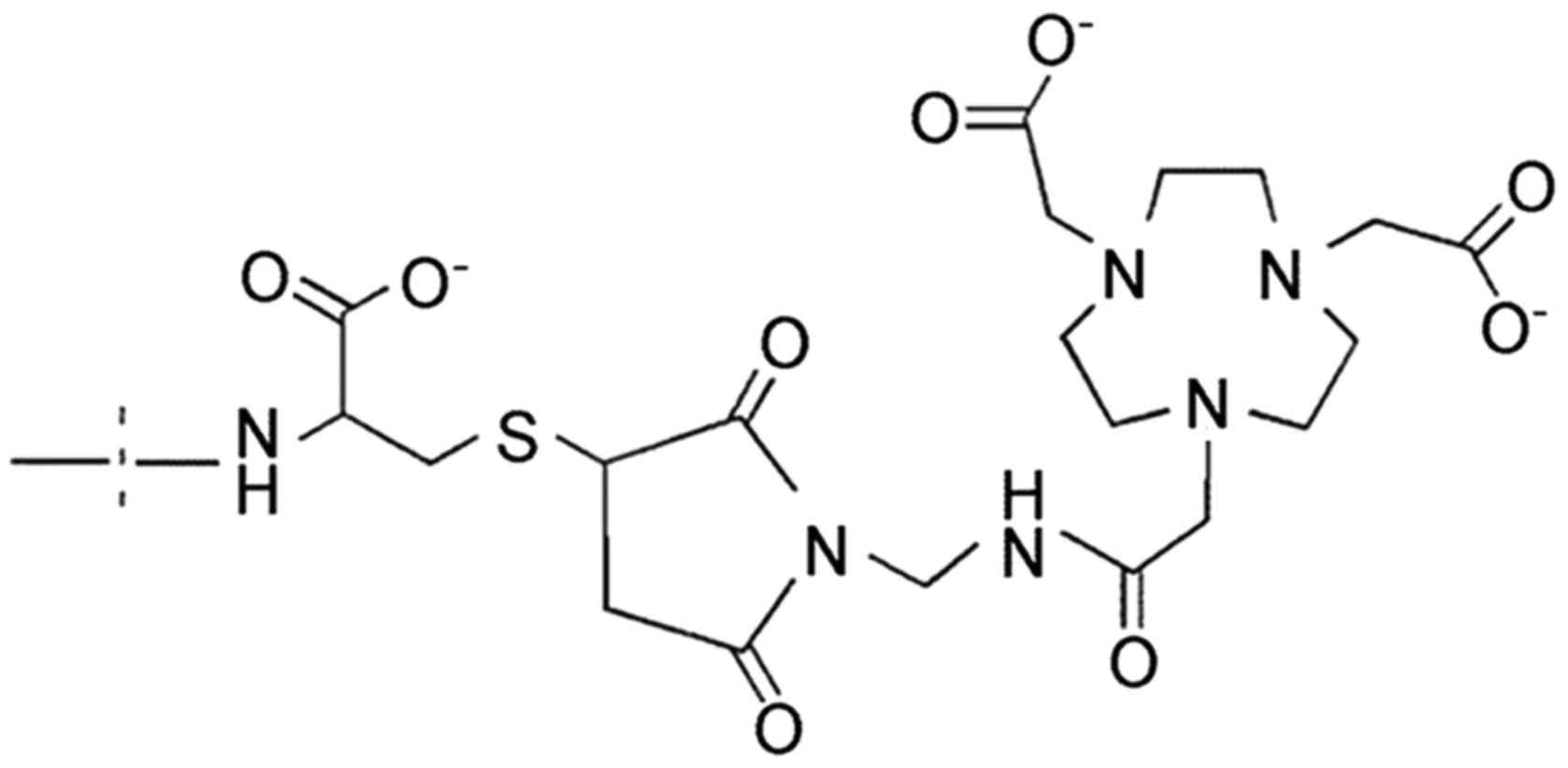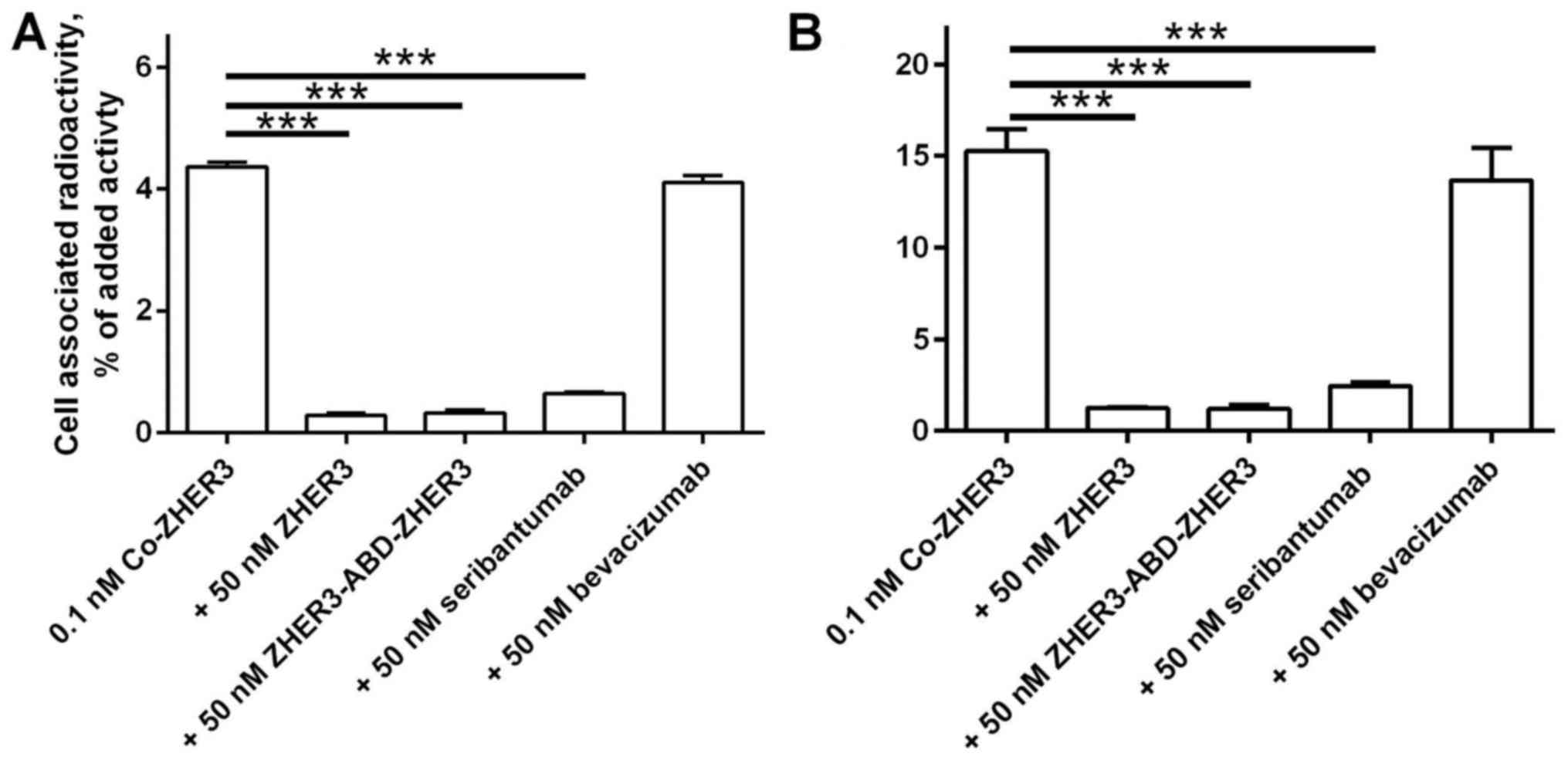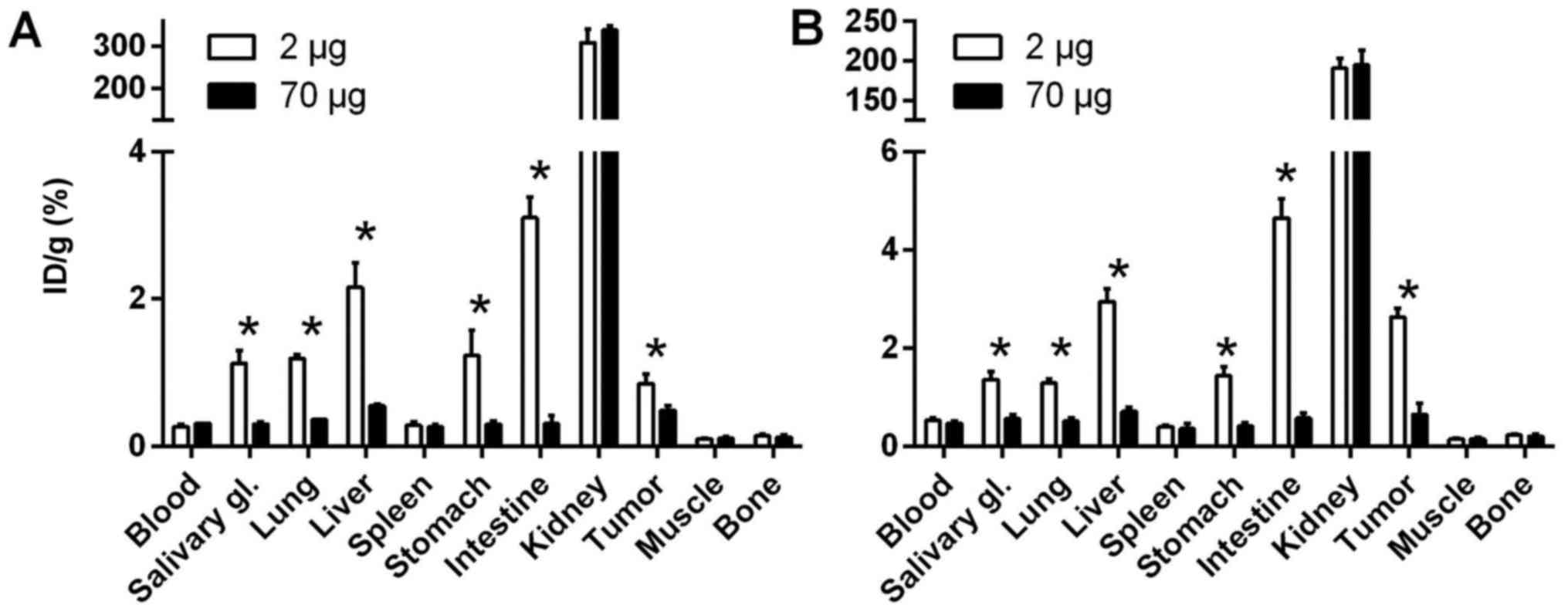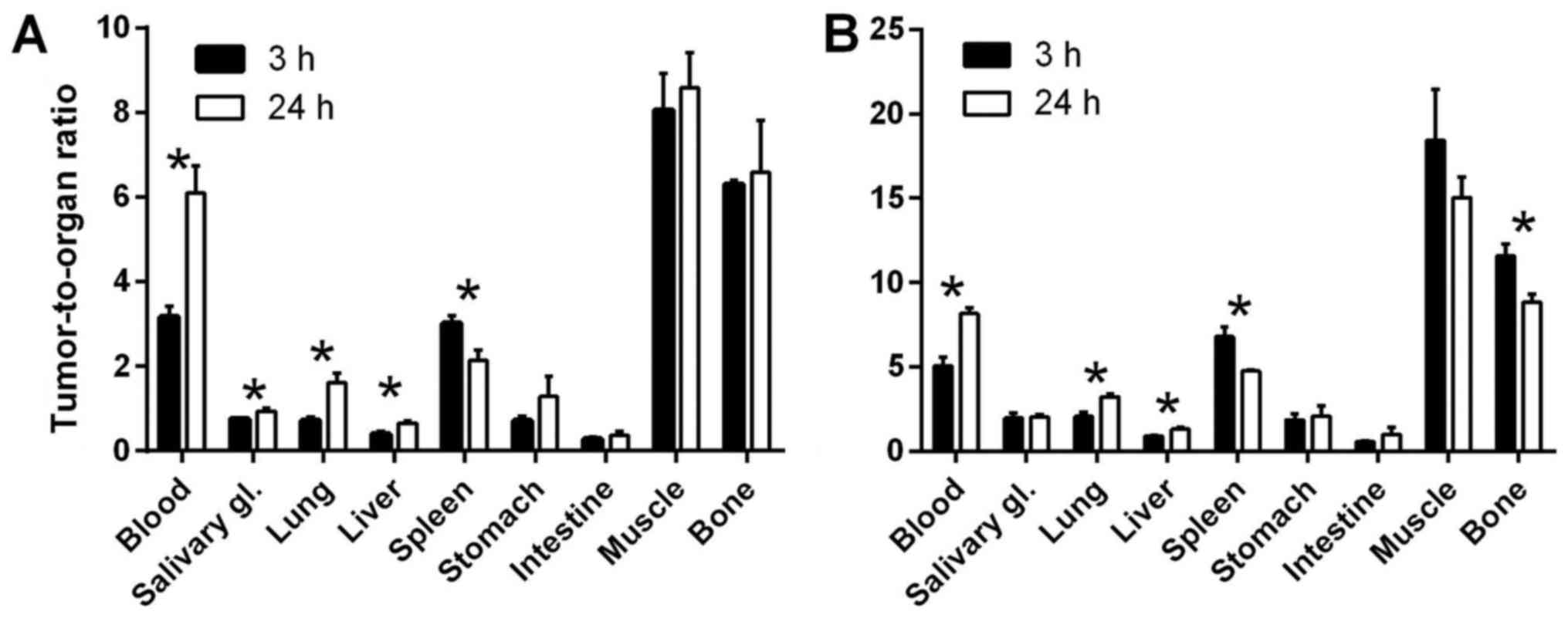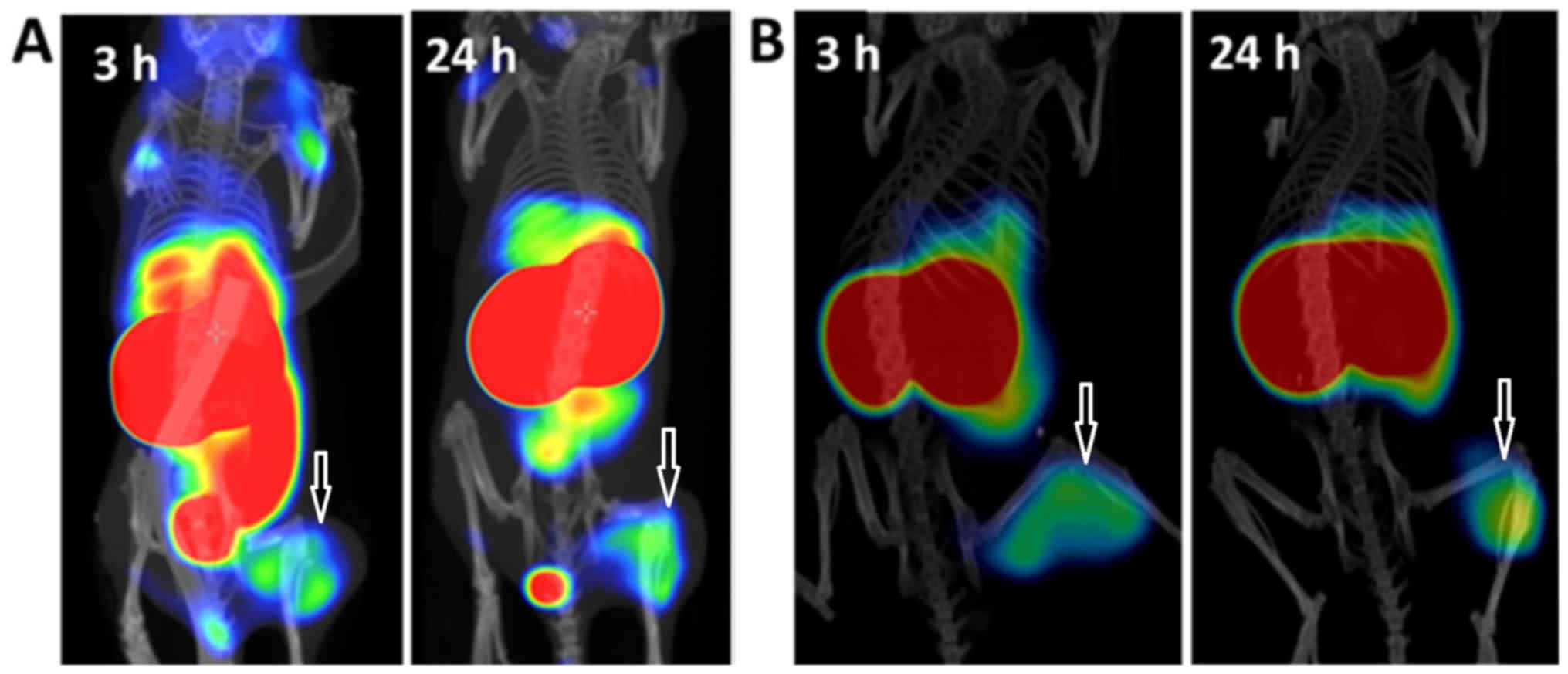|
1
|
Baselga J and Swain SM: Novel anticancer
targets: Revisiting ERBB2 and discovering ERBB3. Nat Rev Cancer.
9:463–475. 2009. View Article : Google Scholar : PubMed/NCBI
|
|
2
|
Malm M, Frejd FY, Ståhl S and Löfblom J:
Targeting HER3 using mono- and bispecific antibodies or alternative
scaffolds. MAbs. 8:1195–1209. 2016. View Article : Google Scholar : PubMed/NCBI
|
|
3
|
Claus J, Patel G, Ng T and Parker PJ: A
role for the pseudokinase HER3 in the acquired resistance against
EGFR- and HER2-directed targeted therapy. Biochem Soc Trans.
42:831–836. 2014. View Article : Google Scholar : PubMed/NCBI
|
|
4
|
Gala K and Chandarlapaty S: Molecular
pathways: HER3 targeted therapy. Clin Cancer Res. 20:1410–1416.
2014. View Article : Google Scholar : PubMed/NCBI
|
|
5
|
Amin DN, Campbell MR and Moasser MM: The
role of HER3, the unpretentious member of the HER family, in cancer
biology and cancer therapeutics. Semin Cell Dev Biol. 21:944–950.
2010. View Article : Google Scholar : PubMed/NCBI
|
|
6
|
Ma J, Lyu H, Huang J and Liu B: Targeting
of erbB3 receptor to overcome resistance in cancer treatment. Mol
Cancer. 13:1052014. View Article : Google Scholar : PubMed/NCBI
|
|
7
|
Mellinghoff IK, Vivanco I, Kwon A, Tran C,
Wongvipat J and Sawyers CL: HER2/neu kinase-dependent modulation of
androgen receptor function through effects on DNA binding and
stability. Cancer Cell. 6:517–527. 2004. View Article : Google Scholar : PubMed/NCBI
|
|
8
|
Leung HY, Weston J, Gullick WJ and
Williams G: A potential autocrine loop between heregulin-alpha and
erbB-3 receptor in human prostatic adenocarcinoma. Br J Urol.
79:212–216. 1997. View Article : Google Scholar : PubMed/NCBI
|
|
9
|
Soler M, Mancini F, Meca-Cortés O,
Sánchez-Cid L, Rubio N, López-Fernández S, Lozano JJ, Blanco J,
Fernández PL and Thomson TM: HER3 is required for the maintenance
of neuregulin-dependent and -independent attributes of malignant
progression in prostate cancer cells. Int J Cancer. 125:2565–2575.
2009. View Article : Google Scholar : PubMed/NCBI
|
|
10
|
Poovassery JS, Kang JC, Kim D, Ober RJ and
Ward ES: Antibody targeting of HER2/HER3 signaling overcomes
heregulin-induced resistance to PI3K inhibition in prostate cancer.
Int J Cancer. 137:267–277. 2015. View Article : Google Scholar
|
|
11
|
Huang Z, Brdlik C, Jin P and Shepard HM: A
pan-HER approach for cancer therapy: Background, current status and
future development. Expert Opin Biol Ther. 9:97–110. 2009.
View Article : Google Scholar
|
|
12
|
Dote H, Cerna D, Burgan WE, Camphausen K
and Tofilon PJ: ErbB3 expression predicts tumor cell
radiosensitization induced by Hsp90 inhibition. Cancer Res.
65:6967–6975. 2005. View Article : Google Scholar : PubMed/NCBI
|
|
13
|
Kol A, Terwisscha van Scheltinga AG,
Timmer-Bosscha H, Lamberts LE, Bensch F, de Vries EG and Schröder
CP: HER3, serious partner in crime: Therapeutic approaches and
potential biomarkers for effect of HER3-targeting. Pharmacol Ther.
143:1–11. 2014. View Article : Google Scholar : PubMed/NCBI
|
|
14
|
Liu JF, Ray-Coquard I, Selle F, Poveda AM,
Cibula D, Hirte H, Hilpert F, Raspagliesi F, Gladieff L, Harter P,
et al: Randomized phase II Trial of seribantumab in combination
with paclitaxel in patients with advanced platinum-resistant or
-refractory ovarian cancer. J Clin Oncol. 34:4345–4353. 2016.
View Article : Google Scholar : PubMed/NCBI
|
|
15
|
Di Cosimo S and Baselga J: Management of
breast cancer with targeted agents: Importance of heterogeneity.
[corrected]. Nat Rev Clin Oncol. 7:139–147. 2010. View Article : Google Scholar : PubMed/NCBI
|
|
16
|
Tolmachev V, Stone-Elander S and Orlova A:
Radiolabelled receptor-tyrosine-kinase targeting drugs for patient
stratification and monitoring of therapy response: Prospects and
pitfalls. Lancet Oncol. 11:992–1000. 2010. View Article : Google Scholar : PubMed/NCBI
|
|
17
|
Pecking AP, Bellet D and Alberini JL:
Immuno-SPET/CT and immuno-PET/CT: A step ahead to translational
imaging. Clin Exp Metastasis. 29:847–852. 2012. View Article : Google Scholar : PubMed/NCBI
|
|
18
|
Robinson MK, Hodge KM, Horak E, Sundberg
AL, Russeva M, Shaller CC, von Mehren M, Shchaveleva I, Simmons HH,
Marks JD, et al: Targeting ErbB2 and ErbB3 with a bispecific
single-chain Fv enhances targeting selectivity and induces a
therapeutic effect in vitro. Br J Cancer. 99:1415–1425. 2008.
View Article : Google Scholar : PubMed/NCBI
|
|
19
|
Tolmachev V, Tran TA, Rosik D, Abrahmsén
L, Sjöberg A and Orlova A: Tumor targeting using Affibody
molecules: An interplay of a target expression level, affinity and
binding site composition. J Nucl Med. 53:953–960. 2012. View Article : Google Scholar : PubMed/NCBI
|
|
20
|
Terwisscha van Scheltinga AG, Lub-de Hooge
MN, Abiraj K, Schröder CP, Pot L, Bossenmaier B, Thomas M,
Hölzlwimmer G, Friess T, Kosterink JG, et al: ImmunoPET and
biodistribution with human epidermal growth factor receptor 3
targeting antibody 89Zr-Rg7116. MAbs. 6:1051–1058. 2014.
View Article : Google Scholar : PubMed/NCBI
|
|
21
|
Yuan Q, Furukawa T, Tashiro T, Okita K,
Jin ZH, Aung W, Sugyo A, Nagatsu K, Endo H, Tsuji AB, et al:
Immuno-PET imaging of HER3 in a model in which HER3 signaling plays
a critical role. PLoS One. 10:e01430762015. View Article : Google Scholar : PubMed/NCBI
|
|
22
|
Tolmachev V, Rosik D, Wållberg H, Sjöberg
A, Sandström M, Hansson M, Wennborg A and Orlova A: Imaging of EGFR
expression in murine xenografts using site-specifically labelled
anti-EGFR 111In-DOTA-Z EGFR:2377 affibody molecule:
Aspect of the injected tracer amount. Eur J Nucl Med Mol Imaging.
37:613–622. 2010. View Article : Google Scholar
|
|
23
|
Orlova A, Magnusson M, Eriksson TL,
Nilsson M, Larsson B, Höidén-Guthenberg I, Widström C, Carlsson J,
Tolmachev V, Ståhl S, et al: Tumor imaging using a picomolar
affinity HER2 binding affibody molecule. Cancer Res. 66:4339–4348.
2006. View Article : Google Scholar : PubMed/NCBI
|
|
24
|
Orlova A, Hofström C, Strand J, Varasteh
Z, Sandstrom M, Andersson K, Tolmachev V and Gräslund T:
[99mTc(CO)3]+-(HE)3-ZIGF1R:4551, a
new affibody conjugate for visualization of insulin-like growth
factor-1 receptor expression in malignant tumours. Eur J Nucl Med
Mol Imaging. 40:439–449. 2013. View Article : Google Scholar
|
|
25
|
Ståhl S, Gräslund T, Eriksson Karlström A,
Frejd FY, Nygren PÅ and Löfblom J: Affibody molecules in
biotechnological and medical applications. Trends Biotechnol.
35:691–712. 2017. View Article : Google Scholar : PubMed/NCBI
|
|
26
|
Ahlgren S and Tolmachev V: Radionuclide
molecular imaging using affibody molecules. Curr Pharm Biotechnol.
11:581–589. 2010. View Article : Google Scholar : PubMed/NCBI
|
|
27
|
Sörensen J, Sandberg D, Sandström M,
Wennborg A, Feldwisch J, Tolmachev V, Åström G, Lubberink M,
Garske-Román U, Carlsson J, et al: First-in-human molecular imaging
of HER2 expression in breast cancer metastases using the
111In-ABY-025 affibody molecule. J Nucl Med. 55:730–735.
2014. View Article : Google Scholar
|
|
28
|
Sörensen J, Velikyan I, Sandberg D,
Wennborg A, Feldwisch J, Tolmachev V, Orlova A, Sandström M,
Lubberink M, Olofsson H, et al: Measuring HER2-receptor expression
in metastatic breast cancer using [68Ga]ABY-025 affibody
PET/CT. Theranostics. 6:262–271. 2016. View Article : Google Scholar
|
|
29
|
Malm M, Kronqvist N, Lindberg H,
Gudmundsdotter L, Bass T, Frejd FY, Höidén-Guthenberg I, Varasteh
Z, Orlova A, Tolmachev V, et al: Inhibiting HER3-mediated tumor
cell growth with affibody molecules engineered to low picomolar
affinity by position-directed error-prone PCR-like diversification.
PLoS One. 8:e627912013. View Article : Google Scholar : PubMed/NCBI
|
|
30
|
Kronqvist N, Malm M, Göstring L,
Gunneriusson E, Nilsson M, Höidén Guthenberg I, Gedda L, Frejd FY,
Ståhl S and Löfblom J: Combining phage and staphylococcal surface
display for generation of ErbB3-specific affibody molecules.
Protein Eng Des Sel. 24:385–396. 2011. View Article : Google Scholar
|
|
31
|
Orlova A, Malm M, Rosestedt M, Varasteh Z,
Andersson K, Selvaraju RK, Altai M, Honarvar H, Strand J, Ståhl S,
et al: Imaging of HER3-expressing xenografts in mice using a
(99mTc(CO)3-HEHEHE-ZHER3:08699 affibody
molecule. Eur J Nucl Med Mol Imaging. 41:1450–1459. 2014.
View Article : Google Scholar : PubMed/NCBI
|
|
32
|
Bass TZ, Rosestedt M, Mitran B, Frejd FY,
Löfblom J, Tolmachev V, Ståhl S and Orlova A: In vivo evaluation of
a novel format of a bivalent HER3-targeting and albumin-binding
therapeutic affibody construct. Sci Rep. 7:431182017. View Article : Google Scholar : PubMed/NCBI
|
|
33
|
Orlova A, Bass T, Atterby C,
Gudmundsdotter L, Frejd FY, Löfblom J, Tolmachev V and Ståhl S:
Evaluating the therapeutic potential of a dimeric HER3-binding
affibody construct in comparison with a monoclonal antibody,
seribantumab. Affibody Molecules Targeting HER3 for Cancer Therapy.
Bass T: Royal Institute of Technology, School of Biotechnology;
Stockholm: 2017
|
|
34
|
Andersson KG, Rosestedt M, Varasteh Z,
Malm M, Sandström M, Tolmachev V, Löfblom J, Ståhl S and Orlova A:
Comparative evaluation of 111In-labeled NOTA conjugated
affibody molecules for visualization of HER3 expression in
malignant tumors. Oncol Rep. 34:1042–1048. 2015. View Article : Google Scholar : PubMed/NCBI
|
|
35
|
Rosestedt M, Andersson KG, Mitran B,
Tolmachev V, Löfblom J, Orlova A and Ståhl S: Affibody-mediated PET
imaging of HER3 expression in malignant tumours. Sci Rep.
5:152262015. View Article : Google Scholar : PubMed/NCBI
|
|
36
|
Da Pieve C, Allott L, Martins CD, Vardon
A, Ciobota DM, Kramer-Marek G and Smith G: Efficient [(18)F]AlF
radiolabeling of ZHER3:8698 affibody molecule for
imaging of HER3 positive tumors. Bioconjug Chem. 27:1839–1849.
2016. View Article : Google Scholar : PubMed/NCBI
|
|
37
|
Fani M, André JP and Maecke HR:
68Ga-PET: A powerful generator-based alternative to
cyclotron-based PET radiopharmaceuticals. Contrast Media Mol
Imaging. 3:67–77. 2008. View Article : Google Scholar : PubMed/NCBI
|
|
38
|
Thisgaard H, Olesen ML and Dam JH:
Radiosynthesis of 55Co- and 58mCo-labelled
DOTATOC for positron emission tomography imaging and targeted
radionuclide therapy. J Labelled Comp Radiopharm. 54:758–762. 2011.
View Article : Google Scholar
|
|
39
|
Jansen HM, Willemsen AT, Sinnige LG, Paans
AM, Hew JM, Franssen EJ, Zorgdrager AM, Pruim J, Minderhoud JM and
Korf J: Cobalt-55 positron emission tomography in
relapsing-progressive multiple sclerosis. J Neurol Sci.
132:139–145. 1995. View Article : Google Scholar : PubMed/NCBI
|
|
40
|
Jansen HM, Pruim J, vd Vliet AM, Paans AM,
Hew JM, Franssen EJ, de Jong BM, Kosterink JG, Haaxma R and Korf J:
Visualization of damaged brain tissue after ischemic stroke with
cobalt-55 positron emission tomography. J Nucl Med. 35:456–460.
1994.PubMed/NCBI
|
|
41
|
Wållberg H, Ahlgren S, Widström C and
Orlova A: Evaluation of the radiocobalt-labeled
[MMA-DOTA-Cys61]-ZHER2:2395(-Cys) affibody
molecule for targeting of HER2-expressing tumors. Mol Imaging Biol.
12:54–62. 2010. View Article : Google Scholar
|
|
42
|
Mitran B, Thisgaard H, Rosenström U, Dam
JH, Larhed M, Tolmachev V and Orlova A: High contrast PET imaging
of GRPR expression in prostate cancer using cobalt-labeled bombesin
antagonist RM26. Contrast Media Mol Imaging. Aug 10–2017.Epub ahead
of print. View Article : Google Scholar : PubMed/NCBI
|
|
43
|
Garousi J, Anderson KG, Dam JH, Olsen BB,
Mitran B, Orlova A, Buijs J, Ståhl S, Löfblom J, Thisgaard H, et
al: The use of radiocobalt as a label improves imaging of EGFR
using DOTA-conjugated affibody molecule. Sci Rep. 7:59612017.
View Article : Google Scholar : PubMed/NCBI
|
|
44
|
Wållberg H and Orlova A: Slow
internalization of anti-HER2 synthetic affibody monomer
111In-DOTA-ZHER2:342-pep2: Implications for
development of labeled tracers. Cancer Biother Radiopharm.
23:435–442. 2008. View Article : Google Scholar
|
|
45
|
Nestor M, Sundström M, Anniko M and
Tolmachev V: Effect of cetuximab in combination with
alpha-radioimmunotherapy in cultured squamous cell carcinomas. Nucl
Med Biol. 38:103–112. 2011. View Article : Google Scholar : PubMed/NCBI
|
|
46
|
Björkelund H, Gedda L, Malmqvist M and
Andersson K: Resolving the EGF-EGFR interaction characteristics
through a multiple-temperature, multiple-inhibitor, real-time
interaction analysis approach. Mol Clin Oncol. 1:343–352. 2013.
View Article : Google Scholar
|
|
47
|
Schoeberl B, Faber AC, Li D, Liang MC,
Crosby K, Onsum M, Burenkova O, Pace E, Walton Z, Nie L, et al: An
ErbB3 antibody, MM-121, is active in cancers with ligand-dependent
activation. Cancer Res. 70:2485–2494. 2010. View Article : Google Scholar : PubMed/NCBI
|
|
48
|
Jansen HM, Knollema S, van der Duin LV,
Willemsen AT, Wiersma A, Franssen EJ, Russel FG, Korf J and Paans
AM: Pharmacokinetics and dosimetry of cobalt-55 and cobalt-57. J
Nucl Med. 37:2082–2086. 1996.PubMed/NCBI
|
|
49
|
Hofström C, Altai M, Honarvar H, Strand J,
Malmberg J, Hosseinimehr SJ, Orlova A, Gräslund T and Tolmachev V:
HAHAHA, HEHEHE, HIHIHI, or HKHKHK: Influence of position and
composition of histidine containing tags on biodistribution of
[(99m)Tc(CO)3](+)-labeled affibody molecules. J Med
Chem. 56:4966–4974. 2013. View Article : Google Scholar
|
|
50
|
Wehrenberg-Klee E, Turker NS, Chang B,
Heidari P and Mahmood U: Development of a HER3 PET probe for breast
cancer imaging. J Nucl Med. 55(Suppl 1): s5502014.
|
|
51
|
Wehrenberg-Klee E, Turker NS, Heidari P,
Larimer B, Juric D, Baselga J, Scaltriti M and Mahmood U:
Differential receptor tyrosine kinase PET imaging for therapeutic
guidance. J Nucl Med. 57:1413–1419. 2016. View Article : Google Scholar : PubMed/NCBI
|
|
52
|
Larimer BM, Phelan N, Wehrenberg-Klee E
and Mahmood U: Phage display selection, in vitro characterization,
and correlative PET imaging of a novel HER3 peptide. Mol Imaging
Biol. Jul 21–2017.Epub ahead of print. View Article : Google Scholar : PubMed/NCBI
|
|
53
|
Garrett JT, Olivares MG, Rinehart C,
Granja-Ingram ND, Sánchez V, Chakrabarty A, Dave B, Cook RS, Pao W,
McKinely E, et al: Transcriptional and posttranslational
up-regulation of HER3 (ErbB3) compensates for inhibition of the
HER2 tyrosine kinase. Proc Natl Acad Sci USA. 108:5021–5026. 2011.
View Article : Google Scholar : PubMed/NCBI
|















